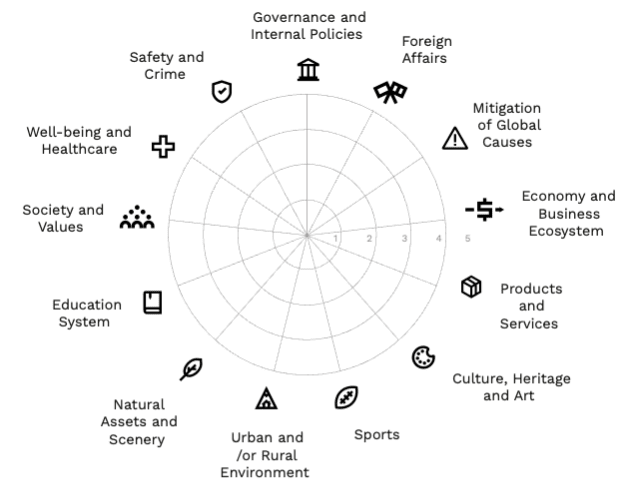Much has been written about the idea that a Nation Brand is not about a logo. It’s a phrase we often repeat at the start of many branding projects, almost like a mantra. And yet, time and again, countries fall into the same trap: creating a logo and “launching the brand”.
The truth is: Nation Branding is never a one-time event. It is an ongoing, adaptive process that demands long-term thinking and strategic intent. Reducing all strategic branding to logo creation often leads to confusion, resistance, and criticism—from citizens, stakeholders, and international audiences alike.
Why do nations keep reaching for logos?
The answer is simple: visibility and ease. Logos are tangible. They are quick to communicate, easy to circulate, and offer a sense of accomplishment. But this shortcut often backfires. There’s a persistent misconception that Nation Brands work like commercial brands. They don’t.
While a commercial logo might drive recognition or product sales, a nation’s identity is far more complex. You can’t reduce centuries of culture, values, history, and a diversity of perspectives and visions into a single emblem.
Ask yourself: What’s the logo of Japan? South Africa? Brazil? Chances are, you either don’t know or can’t recall. But do you have a mental image of what those nations stand for? Most people do. That’s the essence of successful Nation Branding—lasting perceptions, not memorable logos.
Why strategic branding matters for nations
With the increasing polarization of public opinion, evolution of AI and technological hegemony, and consumer “tribes” (eco-conscious travelers, digital nomads, startup entrepreneurs, etc.) has made the importance of narrative management within Nation Branding more influential than ever.
People no longer choose destinations, places to live, work, or do business with based solely on physical attractions like natural beauty or historical sites nor solely on hard infrastructure like universities, leisure spaces, or logistics facilities. They increasingly seek alignment with values, lifestyle, and identity.
That’s where Nation Branding comes in—not as a marketing tool, but as a strategic effort to address conflicting or even destructive narratives and shape long-term perceptions that accurately represent a country’s reality and vision.
Nation Branding strategies help by aligning internal assets—cultural heritage, social values, and industries—with external perceptions of a country. It’s not just about correcting misperceptions, but about building a cohesive story and strategic plan that resonates authentically with domestic stakeholders and international audiences.
Beyond logos: a long-term strategy
Nation Branding is not a communications campaign, nor is it a political ideology. It’s a collaborative, long-term effort to bring together public and private stakeholders, policy, and people to strengthen the country’s strategic positioning.
That means:
- Understanding what the world currently thinks about you and how those visions differ across different audiences, social groups or geographies.
- Defining a desired perception and aligning it with authentic national assets
- Building and aligning policies, initiatives, and narratives with the desired perception and mitigating future risks.
Perception is complex. It’s never just “positive” or “negative.” It’s multifaceted—shaped by factors like safety, governance, education, innovation, global contributions, and more.
At Bloom Consulting, we’ve conducted extensive research in partnership with City Nation Place — collaborating with 66 international experts and institutions such as Universitat Pompeu Fabra and Universitat Autònoma de Barcelona—to identify the key elements that form national perceptions.
These 13 Perception Elements span a variety of assets, from those associated with soft power—such as cultural influence, foreign policy, and political values—to more tangible infrastructure like “Made-in” products, business ecosystems, or healthcare systems. Understanding where your country stands on each element is the foundation of any effective Nation Branding strategy.

Source: Bloom Consulting©
It is also important to distinguish Soft Power from Nation Branding. Soft Power refers to a country’s capacity to influence through attraction and persuasion, whereas Nation Branding is a purposeful, strategic set of actions designed to communicate a country’s values, resources, and features—including its Soft Power assets, as discussed in our previous series of articles.
Where the logo fits in
This doesn’t mean visual identity has no place, but it should go far beyond the emblem and define the overall visual language of Nation Brand or City Brand. When you’ve already conducted the situational analysis, defined your Central Idea, and articulated your perception goals, a visual language can help express the strategy. At that point, a logo becomes a tool, not the strategy itself.
For instance, the Oman Nation Brand visual identity is the result of months of intensive collaboration between local creatives and international designers, built upon rigorous prior research into Oman’s cultural and social representations—conducted through multiple surveys, interviews, and focus groups.
Nation Branding is hard work. It’s political, strategic, emotional, and deeply collaborative. But the temptation to reduce it to a logo is exactly what prevents many countries from building a strong, lasting identity. A logo will not fix perceptions. A long-term strategy with a compelling Central Idea informed by data, inspired by citizens, and applied consistently over time, just might.
For citation purposes: Bloom Consulting (2025): Strategic Branding 101: moving Nation Brands beyond the logo, Bloom Consulting Journal, 5th August. Available at: https://www.bloom-consulting.com/journal/strategic-branding-101-moving-nation-brands-beyond-the-logo/
Published on 05.08.2025.








